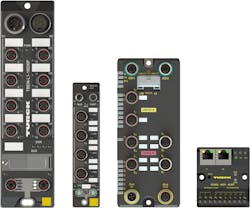Edge computing is one of the hottest trends being touted in manufacturing today for its ability to distribute intelligence and enable Internet of Things (IoT) applications. By bringing control to the device, rather than housing it in a central location, edge computing’s primary use is in relieving the burden put upon the network by the acquisition and analysis of greater amounts of sensor and device data.
Most edge computing applications involve the placement of microprocessors with significant amounts of computing power on or near the device to be controlled. Top shelf, high availability and fault tolerant computing are typically promoted as key aspects of edge computing.
By stepping back from such advanced applications of edge computing and focusing on simple control applications involving dozens—rather than hundreds—of I/O points, Turck has introduced a new edge computing application with its Field Logic Controller (FLC). With this simpler focus, the FLC has a higher potential for adoption by a large number of manufacturers, as well as a means for those manufacturers to explore edge computing.
Microprocessor advances that led Turck to develop the FLC enable I/O blocks to manage both standard I/O functions and the control responsibilities that were formerly only capable through PLCs. Plus, this combination can be achieved “for a fraction of the cost of PLC computing because less hardware and software is required,” says Randy Durick, vice president of fieldbus technology at Turck. “It also brings control into challenging field environments because the FLC blocks carry advanced IP ratings for ingress protection.”
Explaining what led Turck to develop the FLC, Dave Lagerstrom, president and CEO of Turck, says, “User demand was building for simple logic with a clean, web browser-based interface that anyone could program. It was time to build an industrial automation programming environment that was as easy to use as consumer devices.”
FLC uses a flow chart system to program the Ethernet I/O blocks via an HTML5-compatible web browser, such as Chrome or Firefox. Using drop-down menus, engineers can set up multiple conditions, operations and actions on one block. These conditions correspond to input conditions, such as a timer or counter expiring, reaching a certain value, or an input from a sensor becoming true. Operations include Boolean operations, such as “and,” “or” and “not,” while actions correspond to output conditions and tell the block the desired action to execute.
“This functionality was previously possible only through PLCs,” says Durick, “FLCs can now manage these communications on their own. They also allow users to write, run, simulate and debug code.”
To clarify how FLC programming works, Durick offers the following example of an FLC I/O block connected to a level sensor. In this setup, the sensor monitors the liquid level in a tank and reports back to the block. With an ideal level of, say, 50 units—to prevent overfill or the pump running dry—the FLC can be used in place of a PLC to program the block to signal one of three actions:
- When the value is above 50 units, the condition is true. A pump will turn on to return liquid to its ideal level.
- When the value is below 50 units, the condition is true. More liquid will flow into the tank or a pump will be turned off until it reaches the ideal level.
- When the value is 50 units, the condition is false. In this case, no action will be taken because the liquid is at its ideal level.
The three primary uses of FLCs are as a:
- Standalone logic controller—Engineers can use the flow chart interface to program and upload logic directly to the multiprotocol Ethernet I/O block. The block will carry out the actions and report back. No PLC is required.
- Local backup for a PLC—If the PLC loses power or connection, FLC technology can take over the application and run it from the block or safely shut down the process.
- PLC partner—The FLC-capable I/O block can locally monitor and control an application and compile data, and send that data via defined variables to the PLC to lighten its data input and output load. “This is helpful in high speed applications, such as conveyor belts, where sending data in real time can be problematic,” says Durick.
Leaders relevant to this article:


